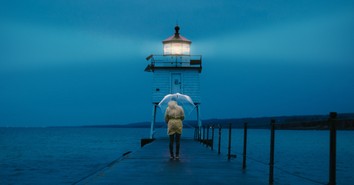FRANKENSTEIN and the Nightmare of a Motherless World

The summer of 1816 was a summer of storms all across Europe. In Switzerland, the waters of Lake Geneva were pelted by incessant rain. The exiles, artists, and eccentrics who had rented houses along the lakeshore were frequently forced indoors. Most often, they gathered at the Villa Diodati, the elegant manse held that year by George Gordon Lord Byron.
Byron was a celebrity. He had been since 1812 when, at the age of 24, he published the first part of his world-weary poem Childe Harold’s Pilgrimage. The poem had captured the spirit of a British elite grown tired of the fashionable promiscuity — the “riot most uncouth” of “concubines and carnal company” — with which they had wiled away the long years trapped on their island by the Napoleonic Wars on the continent. Byron had parlayed his fame into a series of dalliances with the fine ladies of London, and probably some of the fine gentlemen too. At last, he was chased out of the country by debt and the scandal of his collapsing marriage, and a rumored affair with his half-sister.
In Switzerland, he befriended another young English poet, Percy Bysshe Shelley. Shelley had also left his homeland pursued by debt and scandal. Expelled from Oxford for his radical atheist and anti-monarchical views, Shelley had left his wife and children to run off with 16-year-old Mary Godwin, accompanied by Mary’s step-sister Claire. Mary was the daughter of two famous radicals. Her mother, who died shortly after Mary’s birth, was the proto-feminist Mary Wollstonecraft, author of A Vindication of the Rights of Women. Mary’s father, William Godwin, was a rationalist philosopher whose home was a magnet for the free-thinkers of the day.
Mary had lost her first child with Shelley and was currently nursing a second. She called herself Mary Shelley now. But they believed in “Free Love,” all of them: Mary’s parents, her lover, Byron certainly, and Claire who became Byron’s lover and the mother of his child. They despised marriage as a form of slavery. They felt both men and women should be equally free to bed whomever they chose. That was the spirit of the age, an age in some ways very much like ours. Radicals and conservatives were fighting to take control of Europe’s politics. Advances in science had brought religion and the very existence of God into question. And with waning faith and rising atheism, there came all the questions of unbelief. Can truth be known? Does morality exist? Are gender roles God-given or a form of societal oppression?
When the rain and lightning swept in across the waters of the lake, Byron and Shelley, Mary and Claire, and Byron’s hanger-on Dr. John Polidori would gather in the Villa Diodati and talk about it all. With the flamboyant Byron and the intense, neurotic Shelley holding court, Mary would later say she sat by as “a devout but nearly silent listener.” She was a quiet, dreamy woman, deeply devoted to the powerful men in her life. Under Shelley’s influence, she mimicked his extreme philosophies, but his radicalism was never natural to her. After his death, she would gradually become more conservative. She would adopt many of the ideas of the new Christians who called themselves Evangelicals. Her later writings would emphasize and elevate the domestic role of womanhood.
One night that summer, as the Byron party sheltered in the villa from the bad weather, the poets began to read ghost stories from a book called Fantasmagoriana. After they’d been reading a while, Lord Byron declared imperiously to the group, “We will each write a ghost story.” This, anyway, is how Mary remembered it. Over the next days, Byron and Shelley both began to write ghostly tales, but their efforts trailed off. They never finished.
As for Mary: “I busied myself to think of a story… One which would speak to the mysterious fears of our nature, and awaken thrilling horror—one to make the reader dread to look round, to curdle the blood, and quicken the beatings of the heart.” Days went past and inspiration wouldn’t come to her. Then one night, as lightning came flashing in over the lake water, the conversation in the villa turned to the subject of electricity and recent experiments in which electric shocks almost seemed to reanimate the dead.
When the conversation ended, Mary went to bed. As she lay there awake, a nightmare seemed to unfold before her. “With shut eyes, but acute mental vision—I saw the pale student of unhallowed arts kneeling beside the thing he had put together. I saw the hideous phantasm of a man stretched out, and then, on the working of some powerful engine, show signs of life, and stir with an uneasy, half vital motion.” At last, she had her story. The teenage girl was about to create a classic, the first modern science fiction novel: Frankenstein.
The story of the scientist Victor Frankenstein — how he created a living being out of reassembled body parts — is often viewed as a cautionary tale about a man who plays God. Mary herself seemed to see it that way. “Supremely frightful would be the effect of any human endeavor to mock the stupendous mechanism of the Creator of the world,” she wrote. But I don’t think this is what the novel is about at all. Frankenstein does not, in fact, usurp the role of God in creation. He does no more than what men have always done: he makes new life out of existing materials. To me, the horror of the story lies in the fact that Frankenstein usurps the power not of God but of women. He makes a man without a mother. He eliminates the feminine principle from the creation of human life.
Perhaps subconsciously, Mary Shelley seems to have noted that tension had been growing up between the new science and the natural roles and functions of women. The industrial revolution of the mid-eighteenth century already threatened to destroy many of the home industries women ran. The clothing and food once created by wives would soon be made in factories. Even the children women produced were less economically valuable than they had been, because the well-paying factories lured them away to the cities, and they often did not return to help with the family farm.
More than that, new scientific discoveries had given fresh popularity to materialism, the philosophy that there is no spiritual aspect to life, only matter. The ethos of “Free Love,” was a perfect example. It was materialism in the flesh. And what stood in the way of “Free Love” if not the inconvenient arrival of babies, and women’s natural desire to care for them, supported by male commitment and relationship? Women’s sexual equality with men worked very well — for men. But for women — not so much. The wife Shelley deserted when he ran off with Mary drowned herself in the Serpentine in London’s Hyde Park, pregnant with another man’s child. When Claire gave birth to Byron’s daughter, Byron banished the little girl to a convent where she died at the age of five. In later years, Claire would reflect bitterly: “Under the influence of the doctrine and belief of free love I saw the two first poets of England . . . become monsters of lying, meanness, cruelty and treachery.”
In a materialist society reduced to sex and work and market forces, motherhood simply got in the way. It was, after all, a spiritual task at its core. One of the greatest poets of the day William Wordsworth wrote tenderly of how an infant “drinks in the feelings of his mother’s eye,” until, through her love, he learns to see “a virtue which irradiates and exalts” the world. In fact, many scientists now confirm Wordsworth’s insight. They have found that through so-called “mirror neurons” in the brain, mother-child interaction sets a baby on the path to full individual humanity. Without that interaction, as Wordsworth wrote, a person becomes an “outcast,” “bewildered and depressed.”
This is exactly what happens to Frankenstein’s motherless creation in Mary’s novel. Rejected, persecuted, and alone, the creature hides out near a happy emigre family. By observing and eavesdropping on them, he educates himself about the ways of humankind: “the difference of sexes, and the birth and growth of children… how all the life and cares of the mother were wrapped up in the precious charge.” Seeking to become more fully human himself, the creature demands that Frankenstein make a companion for him, a female, an Eve. But Frankenstein, horrified by the work, destroys the new creature before she is completed. Furious, the monster cries out: “I, too, can create desolation!” For the rest of the novel, he goes on a vengeful murder spree to ensure Frankenstein never finds the humanizing love that he has been denied.
Two centuries after Frankenstein was published, the genre Mary Shelley launched—science fiction—has moved to the center of popular entertainment, and the “problems” of femininity and motherhood remain at the center of its concerns. In dystopian sci-fi tales like Brave New World, The Giver and The Stepford Wives, societies of nightmarish inhumanity are created by eliminating, minimizing or neutralizing maternity so that women become either sexual playthings or sexless functionaries. In the monster movie Alien a female creature reproduces by planting her offspring in men leaving the men to explode in a monstrous parody of birth. In the film The Terminator, machines seek to prolong their reign over mankind by sending an android hitman back in time to murder a rebel leader’s mother. In horror stories like Rosemary’s Baby, Carrie and Species, women’s bodies serve as the carriers of demonic or homicidal powers. Throughout Shelley’s genre, femininity and motherhood are understood as the first essential elements of our humanity, an obstacle to materialism and therefore a target of machines and of the devil.
Is real life any different? For those who envision achieving a materialist paradise through science or politics, femininity is a problem to be solved. The inequalities that bedeviled the sex lives of men and women in Mary Shelley’s day have been all but eliminated through birth control and unrestrained abortion. A woman can now medicate her body so that men may use it for their pleasure without consequence or attachment. And should the medication fail, she is legally free to kill the child in her womb.
Some may regard these innovations as atrocities. But others seem to cherish the notion of a genderless future. Some feminists openly yearn for a time when Franken-babies will be created painlessly in womb machines so that women are released at last from the sacrificial duties of homemaking and mother-love that hamper them in the workplace. Indeed, some transgender activists question whether there is any such thing as a natural woman at all. Mary Shelley’s horror novel, then, may have been a vision of our future. Or perhaps, as we Christians believe, there will be not one future but two: one for the saved and one for the, shall we say, salvation impaired.
Because if some, if even a majority, choose to live in a world without created natures where femininity and motherhood are devalued and disdained, believers in the gospel may choose to do otherwise. After all, even God, when he wanted to become fully human, chose first for Himself a mother. The work that transforms matter into humanity, humans into individuals, houses into homes, meals, and chores, and quotidian drudgery into never-forgotten acts of love will remain for some of us what C.S. Lewis said was, “the ultimate career.” If already some belittle that career and seek to eliminate its necessity, well, they too can create desolation.
The rest of us, even outnumbered, will continue to strive to live into God’s image as women and the men who love them.
Photo by David Lezcano on Unsplash

Originally published April 11, 2022.







